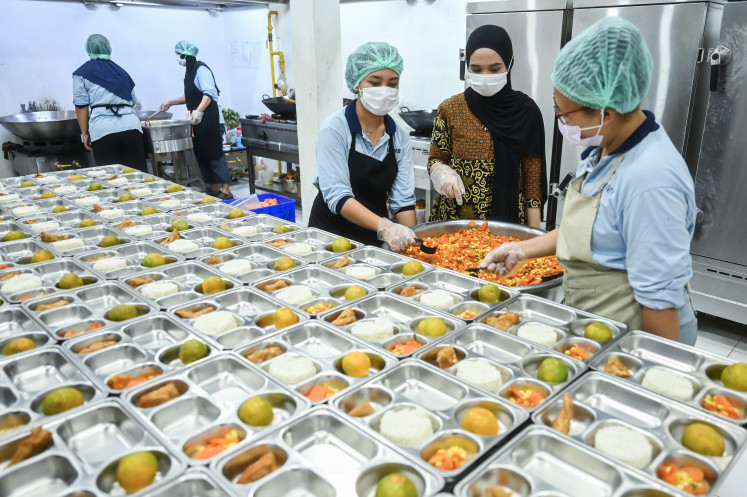Popular Reads
Top Results
Can't find what you're looking for?
View all search resultsPopular Reads
Top Results
Can't find what you're looking for?
View all search resultsWell Being: Crushing the Stones
Dr
Change text size
Gift Premium Articles
to Anyone

Dr. Marto Sugiono, Sp. U: Urology Specialist at Siloam Hospitals Kebon Jeruk.
Words Aulia R. Sungkar Photo Arief Suhardiman
Advanced medical technology has paved the way for more efficient kidney stone treatments, which require smaller incisions, shorter hospital stays, less pain and quicker recoveries.
By the same token, people with kidney stones can take advantage of lithotripsy, a medical procedure to treat stones in kidneys and the urinary tract.
“This non-surgical procedure uses shock waves to break up stones. After the treatment, the stone debris will travel through the urinary tract before passing from the body,” said Dr. Marto Sugiono, Sp. U, a urology specialist at Siloam Hospitals Kebon Jeruk.
J+ recently sat down with the doctor to talk more on ESWL, which has become the preferred weapon in the urologist’s arsenal for treating kidney stones.
The following are excerpts of our interview:
How effective is ESWL procedure for kidney stones?
ESWL is most effective for kidney stones that are less than 1.5 centimeters in diameter. As the name suggests, this type of lithotripsy uses high frequency sound waves, also called high-energy shock waves, to break up kidney stones into smaller pieces. Extracorporeal means “situated outside the body”, which in this case refers to the shock waves originating from outside. An ESWL session requires the use of ultrasound or X-rays to target the location of the stone and a device to generate the shock waves. The waves travel through the body to pulverize the kidney stones.
There are, however, several brands of lithotripter machine, each with different levels of effectiveness. We use a piezoelectric shock wave device that is made in Germany.
What makes the piezoelectric sound wave technology unique?
The technology boasts the least painful way of breaking the stones into tiny particles. There are other devices that are also powerful, but in many cases the use of these devices requires anesthesia to reduce the pain and discomfort during an ESWL session. This means increasing the cost and possible complication rate and patients may not be able to go home on the same day.
With the piezoelectric lithotripter, patients generally do not feel pain. Even if they do, the discomfort is usually manageable with analgesia. All in all, it’s an anesthesia-free device that allows for a speedier recovery.
How long does the treatment take?
It takes only around an hour for an ESWL session. In some cases, the stone cannot be fragmented with only one treatment. A number of sessions may be required depending on the size of the stone. For instance, a patient with a 2-cm stone may need to undergo two to three treatments. If he or she only has a 6-mm stone, perhaps only one treatment will do.
Are there kidney stones that cannot be treated with ESWL?
ESWL does not work well for very large stones, especially those larger than two or three centimeters. For such large stones, other surgical options may be more cost effective.
Pregnant women and patients with blood clotting problems also should definitely not undergo ESWL. Moreover, ESWL is also not suitable for patients with uncontrolled high blood pressure or who have not stopped their blood thinning medication. Teenagers may be suited for ESWL treatment in select cases.
Understanding the Basics
Indonesia is located in the so-called stone-forming belt. The country’s geographic location, which straddles the equator, is counted as one of the world’s highest kidney stone incidence areas.
“The effect of geography on the incidence is pretty obvious. The country’s tropical climate, with a relatively high humidity, increases the rate of perspiration, which in turn promotes increased urinary crystallization, thus contributing to the risk of kidney stones,” Dr. Marto said.
“Kidney stones are formed when certain chemicals in the blood crystallize. This crystallization forms solid stones that are lodged in the kidney.”
The pain from passing a kidney stone can be unbearable, while some stones can stay lodged in the kidney for years without much pain.
In search of a remedy, doctors have dubbed ESWL the most sought-after non-surgical procedure for the treatment of kidney stones. “ESWL’s minimal pain and quick recovery are the factors that determine its popularity, yet the treatment does not replace the need for preventive measures,” Dr. Marto said.
Preventing kidney stones is not that difficult, but it takes determination to succeed. “You need to drink enough water; have a healthy and balanced diet, including fruits and vegetables; and avoid eating too much salty food and red meat, like mutton, lamb, beef or pork. Instead, eat more white meat, such as chicken or fish; consume less peanuts; and be careful with high uric-acid containing seafood, like crab and prawns,” he said.
These articles are part of a continuing series sponsored by Siloam Hospitals.









